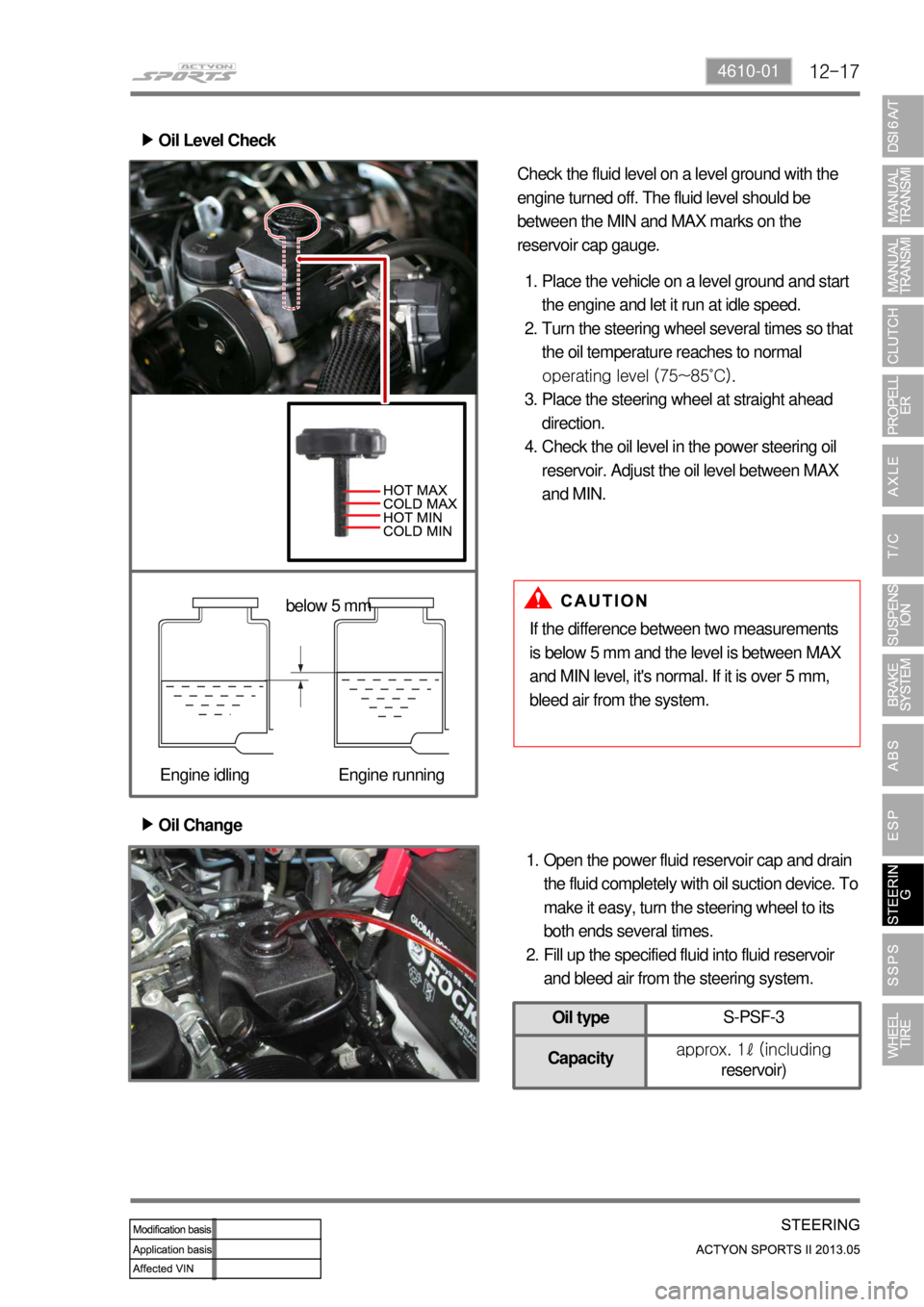Page 23 of 751
01-6
3. ENGINE COMPARTMENT LAYOUT
Do not work on the engine compartment while the engine, radiator, exhaust manifold, muffler or
catalytic converter is hot. Always turn the engine off and allow it to cool before starting the
maintenance.
Regularly check the engine oil level and add Ssangyong genuine engine oil if necessary.
Clean the dipstick with clean cloth so that any foreign materials cannot get into the engine. -
-
-
Power steering fluid
reservoirBrake fluid reservoir
Fuse & relay
Engine oil dipstick
gaugeWasher fluid
reservoir cap Engine oil filler cap
Air cleaner
Operating vehicle with insuffi cient amount of oil can damage the engine. Make sure the engine oil
level is correct and add oil if necessary.
Coolant reservoir
Page 258 of 751

01-91113-01
4. DIAGNOSTIC INFORMATION AND PROCEDURE
1) Oil Leak Diagnosis
Most fluid oil leaks are easily located and repaired by visually finding the leak and replacing or repairing
the necessary parts. On some occasions a fluid leak may be difficult to locate or repair. The following
procedures may help you in locating and repairing most leaks.
Finding the Leak ▶
Identify the fluid. Determine whether it is engine oil, automatic transmission fluid, power steering
fluid, etc.
Identify where the fluid is leaking from. -
-
After running the vehicle at normal operating temperature, park the vehicle over a large sheet
of paper.
Wait a few minutes.
You should be able to find the approximate location of the leak by the drippings on the paper. ·
·
·
Visually check around the suspected component.
Check around all the gasket mating surfaces for leaks. A mirror is useful for finding leaks in
areas that are hard to reach.
If the leak still cannot be found, it may be necessary to clean the suspected area with a
degreaser, steam or spray solvent. -
-
Clean the area well.
Dry the area.
Operate the vehicle for several miles at normal operating temperature and varying speeds.
After operating the vehicle, visually check the suspected component.
If you still cannot locate the leak, try using the powder or black light and dye method. ·
·
·
·
·
Clean the suspected area.
Apply an aerosol-type powder (such as foot powder) to the suspected area.
Operate the vehicle under normal operating conditoins.
Visually inspect the suspected component. You should be able to trace the leak path over the
white powder surface to the source. -
-
-
- Powder Method ▶
Page 646 of 751

12-174610-01
Oil Change ▶
Open the power fluid reservoir cap and drain
the fluid completely with oil suction device. To
make it easy, turn the steering wheel to its
both ends several times.
Fill up the specified fluid into fluid reservoir
and bleed air from the steering system. 1.
2. Oil Level Check ▶
Place the vehicle on a level ground and start
the engine and let it run at idle speed.
Turn the steering wheel several times so that
the oil temperature reaches to normal
operating level (75~85˚C).
Place the steering wheel at straight ahead
direction.
Check the oil level in the power steering oil
reservoir. Adjust the oil level between MAX
and MIN. 1.
2.
3.
4.
If the difference between two measurements
is below 5 mm and the level is between MAX
and MIN level, it's normal. If it is over 5 mm,
bleed air from the system. Check the fluid level on a level ground with the
engine turned off. The fluid level should be
between the MIN and MAX marks on the
reservoir cap gauge.
below 5 mm
Engine idling Engine running
Oil typeS-PSF-3
Capacityapprox. 1ℓ (including
reservoir)
Page 650 of 751

12-214610-01
1. SYSTEM DESCRIPTION
The power steering has been designed to make the wheel move more easily than in a manual steering
system. The hydraulic power assists the process utilizing hydraulic fluid. The fluid increases pressure in
the power steering pump and aids the movement of the steering mechanism. The power steering
system consists of pump, oil reservoir, rack and gear box. The power steering pump is a vane type and
delivers hydraulic pressure to operate the power steering system. The pressure relief valve in the pump
controls the discharging pressure. The rotary valve in the rack and the pinion gear directs the oil from the
power steering pump to one side of the rack piston. The integrated rack piston converts the hydraulic
pressure to linear movement. The operating force of the rack moves the wheels through the tie rod, the
tie rod end and the steering knuckle. Even though the hydraulic pressure cannot be generated, a driver
can steer the vehicle without power assist but it needs very high steering force. In this case, the
operating force of the steering wheel is conveyed to the pinion, and the movement of the pinion moves
the rack through the pinion gear combined to the rack gear.
Page 653 of 751
13-34620-01
1. SPECIFICATIONS
Item Item Specification
SSPS solenoid valveRated voltage DC 12 V
Rated voltage 1.0 A
Resistance6.7 ±1 Ω
Power steering oil pump
(with SSPS)Operating temperature-40℃~150℃
Release pressure 90 bar
Displacement 9.3 cc/rev
Flow velocity 9.75~6 l/mn
Pulley sizeØ115
Pulley type 6 groove
Housing material Aluminium
Power steering fluid reservoir
(with SSPS)Fracture pressuremin 8kgf/㎠
Air leakage2 kgf/㎠×min
Cap open torque 9.8 to 14.2 Nm
Oil capacity FULL 550cc
Power steering gear box
(with SSPS)Gear type Rack & pinion type
Gear ratio 40.245
Fixed rack 3.78
Gear weight 12.800 kg
Steering angleInner36.2°
Outer32.4°